In a call center, small mistakes can snowball fast - turning what should be a quick win into a frustrating repeat call. Even the most experienced agents can slip into bad habits that quietly chip away at customer satisfaction and loyalty. These oversights can negatively impact key performance metrics—especially Customer Satisfaction (CSAT) and First Call Resolution (FCR)—as well as long-term loyalty and brand reputation.
This blog will spotlight seven of the most common mistakes call center agents make—and explain how you can avoid them, using proven SQM insights. Whether you’re leading a team, designing training programs, or simply striving for continuous improvement, these lessons can help elevate every interaction and drive stronger results.
1. Not Actively Listening to the Customer
Failing to practice active listening is more than just poor manners—it’s a performance killer. When agents interrupt customers, multitask during calls, or start formulating responses before listening fully, they risk misunderstanding issues and failing to offer accurate solutions.
Many repeat calls occur because agents didn’t capture critical details during the first interaction, leading to longer handling times and frustrated customers. Even more, interactions with poor listening behaviors contribute to a drop in CSAT, highlighting the direct link between presence on the call and customer satisfaction.
How to Avoid It
- Use verbal affirmations like “I understand” or “That makes sense” to demonstrate engagement and keep the conversation flowing.
- Paraphrase their concerns (“So what you’re seeing is…—is that correct?”) to confirm mutual understanding.
- Minimize distractions—close other tabs, mute notifications, and eliminate background noise to remain fully present.
- Train for mindfulness, encouraging agents to consciously pause before responding and prioritize listening over closing the call quickly.
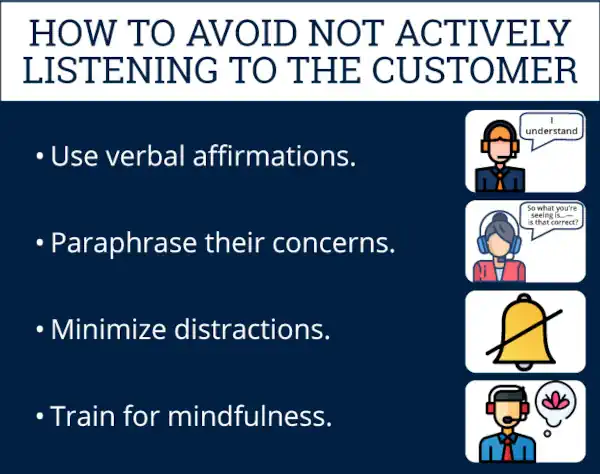
2. Over-Reliance on Scripts
Scripts are designed to provide structure, consistency, and compliance—but when agents stick to them word-for-word without adapting, conversations can feel cold, mechanical, and disconnected from the customer’s real needs. Instead of sounding professional, it can come across as if the agent is on autopilot.
When a customer senses that they’re just being “read at” rather than spoken to, they’re less likely to open up about the real problem. That means important details can be missed, and the resolution may fall short of expectations. Over time, this can erode trust and reduce customer loyalty—even if the technical issue is resolved.
How to Avoid It
- Use scripts as a guide, not a crutch. Treat them like a safety net rather than a checklist to be read verbatim.
- Match the customer’s tone and pace. A friendly, upbeat caller may respond best to a warm, casual approach; an urgent caller may appreciate a more direct, concise style.
- Personalize wherever possible. Using the customer’s name, referencing details they’ve shared, or acknowledging their unique circumstances makes a big difference.
- Train for conversational agility. Role-play scenarios where agents must respond without relying on scripted answers, building confidence in unscripted interactions.
The best calls combine the clarity of a script with the warmth and flexibility of genuine human conversation.
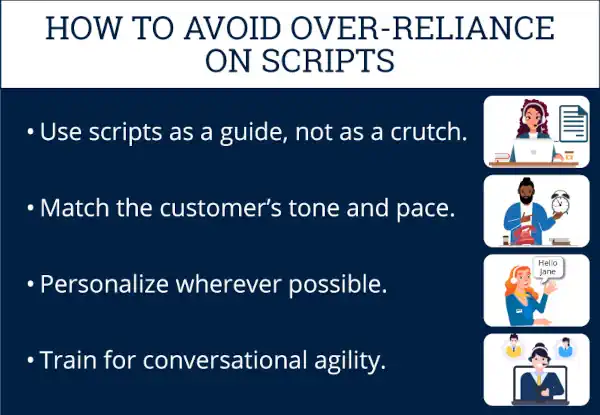
3. Providing Incorrect or Incomplete Information
In the pressure to wrap up a call quickly, some agents guess at answers or provide only partial information. While it might seem faster in the moment, it often leads to confusion, repeat calls, and more frustration for the customer.
Even if an agent solves part of the problem, missing or inaccurate details can undo all their hard work. Customers might end up calling back to clarify, double-checking with another representative, or—even worse—losing confidence in the company’s credibility. This not only increases call volume but can also hurt first call resolution rates and overall satisfaction.
How to Avoid It
- Verify before you share. If you’re not sure about an answer, take a moment to confirm it through the knowledge base or a team lead.
- Don’t be afraid to say, “I don’t know—let me find out.” Customers appreciate honesty far more than confident misinformation.
- Give the full picture. If there are limitations, next steps, or potential follow-up actions, explain them upfront so there are no surprises.
- Encourage documentation habits. Logging solutions and sharing knowledge helps the entire team avoid repeated errors.
Accurate, complete answers aren’t just about solving problems—they build long-term trust and reduce avoidable work for both agents and customers.
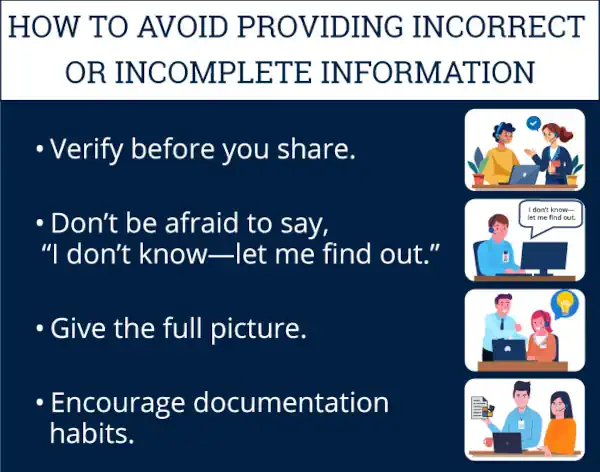
4. Poor Call Control and Time Management
Some calls go off the rails because the agent loses control of the conversation. This can happen when the customer strays into unrelated topics, when the agent rushes them through key details, or when there’s no clear plan for resolving the issue.
Without good call control, conversations can become unfocused, stretching handle times and leaving customers feeling unheard—or worse, unresolved. On the flip side, rushing a caller can cause critical details to be missed, forcing follow-up calls and damaging satisfaction scores.
How to Avoid It
- Guide with purpose. Use bridging phrases like, “Let’s focus on the main issue first, then I can address the other points.”
- Balance empathy with efficiency. Show you care, but keep the resolution process moving forward.
- Set expectations early. Let the customer know the steps you’ll take so they feel confident in the process.
- Learn to redirect gently. If the customer wanders off-topic, acknowledge their point, then steer back to the main concern.
Effective call control isn’t about being rigid—it’s about creating a conversation that is both respectful and productive.
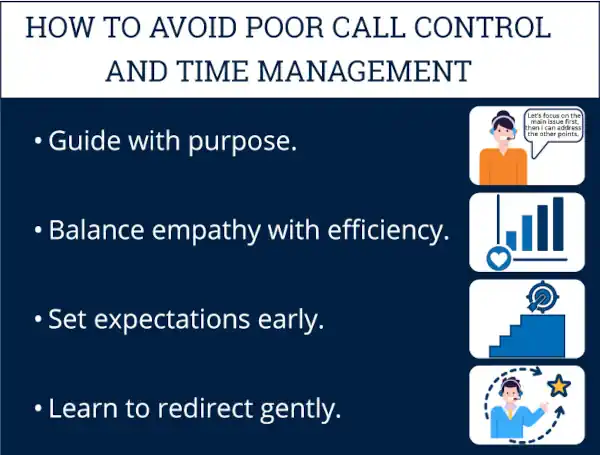
5. Failing to Show Empathy
Technical knowledge solves problems, but empathy solves people. When agents treat a call as just another task to complete rather than an opportunity to connect, customers may leave the interaction feeling like a transaction instead of a valued person.
A lack of empathy can make even a successful resolution feel unsatisfying. Customers remember how they were treated, and emotional disconnects can erode loyalty over time. Without empathy, agents also risk escalating tensions unnecessarily when customers are already stressed or upset.
How to Avoid It
- Acknowledge feelings before fixing the issue. A simple “I can understand how frustrating that must be” can immediately ease tension.
- Mirror the customer’s emotional tone. If they’re worried, respond with reassurance; if they’re upbeat, keep the energy positive.
- Use human language, not corporate jargon. Plain words feel more genuine than scripted formalities.
- Train empathy as a skill. Include role-plays that focus on emotional intelligence, not just technical problem-solving.
Empathy isn’t about overpromising—it’s about making the customer feel heard and respected, even when the solution isn’t ideal.

6. Not Following Up When Promised
Sometimes an issue can’t be fully resolved during the first call, and a follow-up is necessary. The problem arises when an agent promises to call back or send an update—but doesn’t.
Broken promises quickly erode trust. Even if the eventual resolution is solid, failing to follow through leaves customers feeling ignored or misled. This can turn a neutral experience into a negative one, and it often results in extra inbound calls from customers chasing updates.
How to Avoid It
- Log every follow-up in the CRM. Treat it as a firm commitment, not an optional extra.
- Set reminders or use automated prompts so no follow-up slips through the cracks.
- Over-communicate when delays happen. A quick check-in to say “We’re still working on it” goes a long way in maintaining trust.
- Close the loop completely. Always let the customer know when the case is resolved, even if they didn’t request confirmation.
Consistent follow-up is one of the simplest ways to turn a potentially negative experience into a loyalty-building moment.
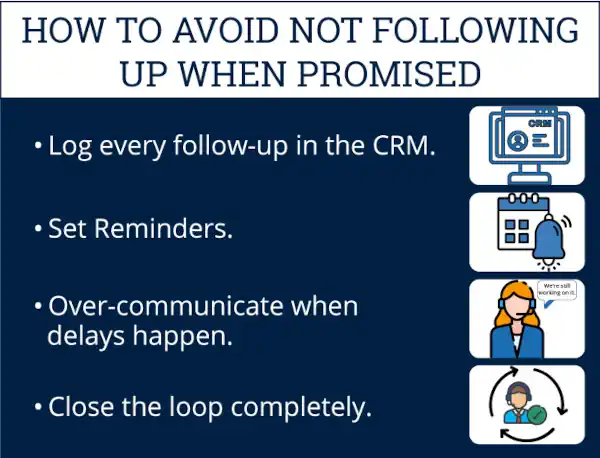
7. Ignoring Customer Feedback
Customer feedback—whether through surveys, reviews, or direct comments—offers a goldmine of insight. The mistake comes when agents or organizations dismiss it as unimportant, overly negative, or irrelevant.
When feedback is ignored, the same mistakes are repeated. Customers notice when their input isn’t acted on, which can lead to declining satisfaction and higher churn rates. Worse, valuable improvement opportunities are missed entirely.
How to Avoid It
- Review survey results regularly. Look for patterns in low scores and specific comments.
- Act on both positive and negative feedback. Reinforce what’s working and address what’s not.
- Share insights across the team. Feedback should inform coaching sessions and process changes, not sit in a report.
- Show customers they’ve been heard. Let them know when their suggestions lead to changes—it builds goodwill and loyalty.
Feedback is free coaching from the people who matter most—your customers. The smartest teams treat it as a priority, not an afterthought.
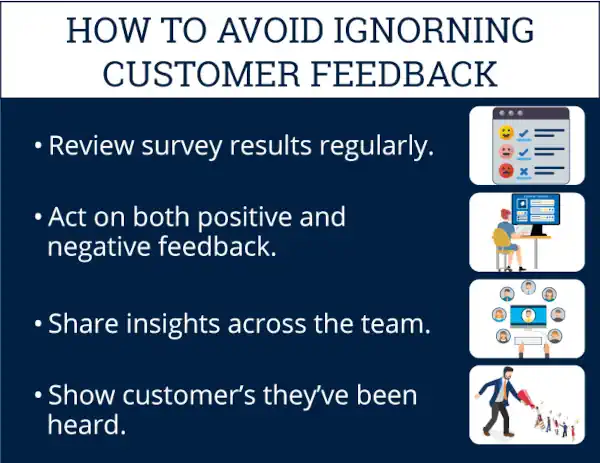
mySQM™ QA combines AI-powered call scoring with traditional QA methods to evaluate 100% of calls—delivering benchmarkable customer satisfaction predictions and actionable insights.
Using both automated and manual quality assurance, mySQM™ QA captures, analyzes, and reports on call quality across:
- Customer service performance
- Call compliance
- Metadata
By leveraging CX sentiment, compliance, metadata, and benchmark data, mySQM™ QA transforms your QA program—helping you deliver exceptional customer experiences, reduce costs, safeguard compliance, and accurately predict CSAT.
